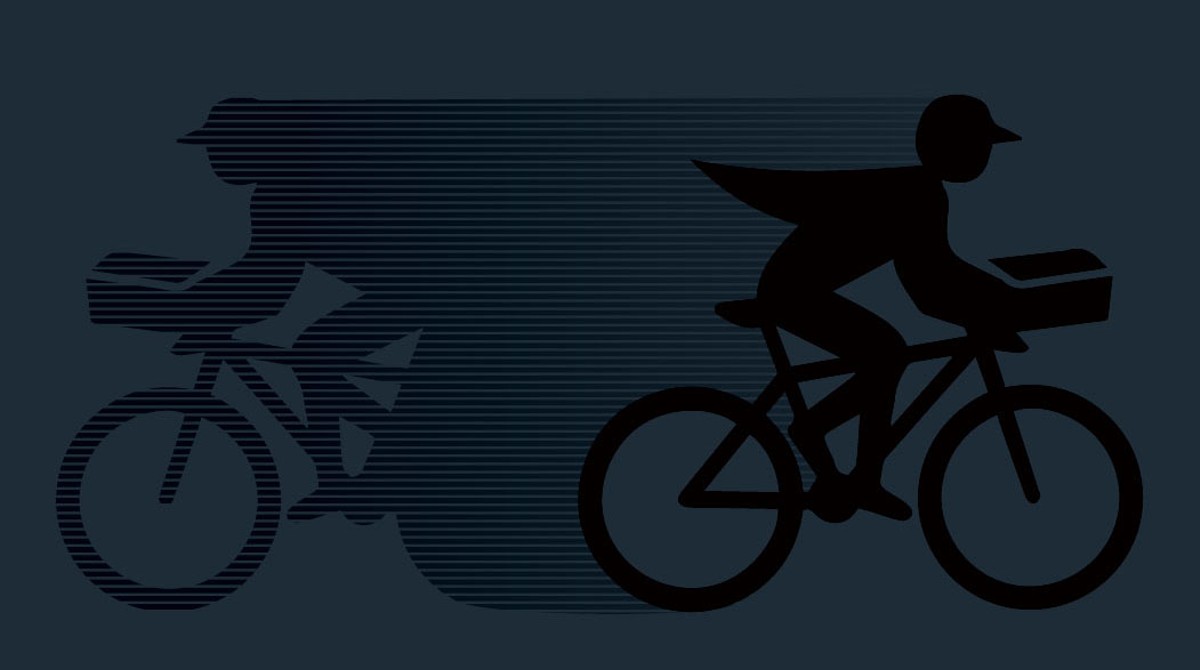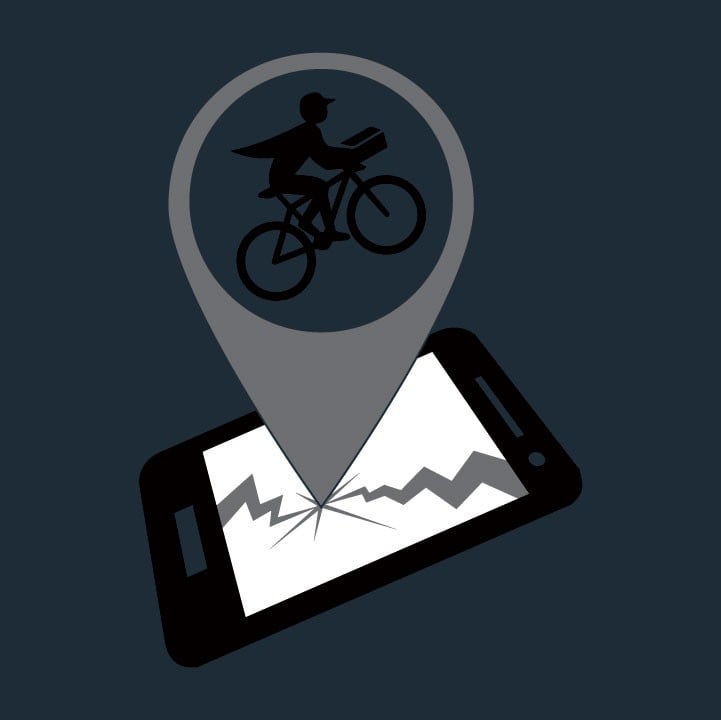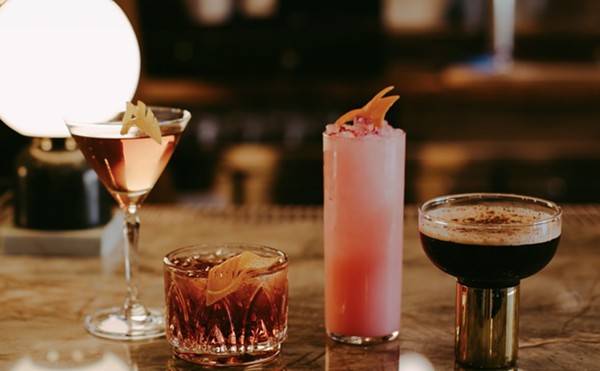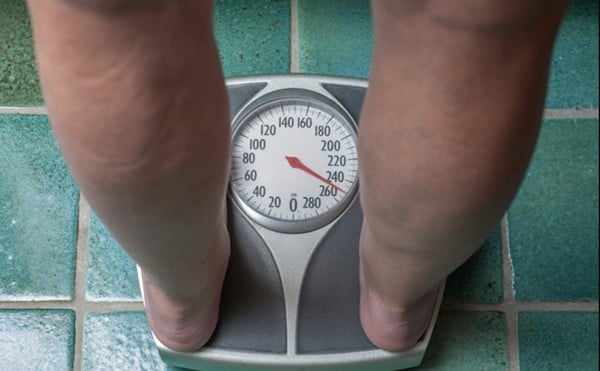In the interest of allowing the subject to speak freely, let’s call my friend Adam. As in “you don’t know him from Adam.” The old idiom. You know it, right?
So Adam is an accomplished local musician. And as the United States unmistakably values its arts, he is able to earn a fair and living wage. At least as far as alternative facts go, right folks?
No, no, at the nexus of the Bevin-Trump-Pepe continuum, dude’s gotta hustle with a myriad of side gigs. One of them includes delivering the brunch you’re too hungover to grab yourself, through Louisville’s latest foray into the sharing economy. Enter San Francisco-based Postmates, debuting here in early December to a promotional blitz with free food and drink offers. The sort of stuff they call in retail “loss leaders.”
Like an Uber for food (but not Uber Eats), Postmates features popular restaurant menus within an app environment. Place your order, and a driver will pick it up and deliver it for you, which you can track in real time via GPS. There’s no order minimum, unlike competitors GrubHub and Seamless, with comparable delivery fees. Invite your friends with a code and earn free deliveries yourself (Postmates has thankfully not blown up Facebook events with these types of promotions yet). Everything that falls under the standard sharing economy app M.O.
What makes Postmates different, however, is the choice. From LEO Weekly world headquarters on historic West Main Street, one block down from David’s big golden butt in front of the 21c Museum Hotel, Seamless and GrubHub (which have been the same company since 2013) offer up Wei Wei Chinese Express, BJ’s Brewhouse, Chili’s, Ditto’s Grill, and Chuy’s as the first five options. Yuck. Thumbs down. Postmates, on the other hand, renders El Taco Luchador, La Que, Bunz, Heart & Soy, and other beloved local institutions, laid out in a clean and crisp user interface. While there are some delicious, Welp-approved Louisville eateries represented in the Seamless-GrubHub complex including Falafel House, Yummy Pollo and Abyssinia, they are dwarfed by chain restaurants and snooze-inducing continental cuisine. Postmates, by way of both their design and delivery selection, looks more appetizing all around.
I first ordered from Postmates within a week of its launch. I felt crummy, found myself without groceries and Kashmir sounded revelatory. I opened up the app and smashed that Get It Now button on my order faster than you can say “I know I’m white af, but, please give me the Indian-hot level — I need this.” The Postmates driver arrived within a half hour, a luminescent pink Lyft mustache and Uber sticker affixed to his front windshield. Grabbing a sack full of effervescent healing crystals in the form of turmeric-rich cuisine, I plopped back down on the couch with my chicken tikka masala and continued watching HBO’s Silicon Valley — a synchronicity not lost on me. It was awesome.
However, the masala wasn’t my first choice. I originally ordered Thali — a large platter of chef’s choice curries and fresh chutneys with rice and naan, like an Indian version of dim sum — and thought it strange that a restaurant would actually try and box up such a meal. I gave it a go anyway. The driver called me shortly after to say they had to cancel my order — this beautiful spread of complementary flavors proving to be a non-starter — and I needed to place a new order with a new driver. Not a huge deal, but it made me wonder why it was available as a choice in the first place.
That was about the time another restaurant’s Facebook page commented on a recent post on the Welp! page about my excitement for Postmates coming to town.
“Technically, they're just delivering all kinds of restaurants without asking for permission. Which is fine until they mess something up and the restaurant looks bad for it.”
You don’t say. So what do other restaurants have to say on the matter? Or Postmates? Or Adam?
**********
Adam invited me to ride along with him for a few hours on a late December morning on a food-delivery vision quest. We met up for coffee shortly after 10 a.m., placing the phone at the center of the table with app open and bated breath. He runs me through some of the basics of his nascent Postmates journey: how he was subjected to a standard background check, while never receiving any official training, either in person or via webinar. His vehicle didn’t meet Uber/Lyft requirements, but that was immaterial to Postmates. The company sent him a pretty sweet hot bag to keep the food warm, as well as a company debit card, whose balance replenishes in perpetuity. This is how drivers pay for the food.Actually, let’s let the record scratch and back up for a second to walk through the process. You, to make use of marketing parlance “the end user,” choose from a list of restaurants and place your order through the app. That information forwards to a call center. The operator calls that restaurant to place the order to go… provided the restaurant accepts orders over the phone (as I learned with my second Postmates experience with El Molcejete, not all do, so the driver had to order in person and wait for its preparation… yes, I did tip her extra for the effort). The driver heads to the restaurant, pays for the meal with the Postmates card, and couriers the food. Afterward, the end user — that’s you, buddy — can elect to leave gratuity and a rating.
The selection is massive, shuttling not just a wide range of food options, but also non-food items too. Walgreen’s is on the app, which means you could get cough medicine, ibuprofen and/or condoms delivered right to your door, all products one needs in moments when leaving the home is less than palatable. And that is clutch.
The driver collects a portion of the delivery fee, which varies depending on the length of the trip, as well as any applicable gratuity. Unlike Uber, drivers cannot rate the customer. Adam mentions, in his experience, that North End Cafe and Highland Morning are popular with the delivery service. Other businesses, he said, have little to no awareness of the app’s existence, expressing confusion at a third party picking up someone else’s food. This extended to the staff of a well-known burger joint, he said, a business that was actually part of one of the app’s limited launch promotions that included a free cheeseburger and fries to entice app engagement. I was not able to track down the manager on duty the day of the promotion, but according to Adam, the staff seemed unequipped to handle such an atypical rush — especially for a fast casual joint near a university over winter break. Regardless of what happened at that esteemed burger diner, it still yields a tough decision for a restauranteur or manager — is it worth risking the quality of your product plus the staffing necessary to execute unusually high volume orders at the benefit of creating exposure and a few extra sales? And how well is this startup, an app featuring delivery from trendy restaurants who seemed to burst on the scene like the Kool-Aid Man, communicating with these businesses?
Confidence certainly wasn’t engendered after our first delivery. Pulling up to the front door to pick up the debut order of the morning, the restaurant was closed.
Ryan Rogers, owner of Feast BBQ and Royal’s Hot Chicken, was contacted by Postmates. Not for permission, though, but to sell a partnership opportunity, which gives you more control, and more visibility to customers. “I wanted to be on the app, but I needed to know how I was going to be charged,” Rogers said. Their original pitch, according to Rogers, included a 20-percent commission. “So if it’s a $20 ticket, I would pay $4. I said: ‘Cool, thanks but no thanks. That’s more than our entire margin.’ We would lose money with every Postmates order.”
Both his restaurants remain on the app, which he has no problem with — he just didn’t think the extra cost for the partnership was worth it. Rogers said he has seen an uptick in sales — his stores have even added a button on the point of sale if the employee believes an order came from Postmates — but he remains skeptical that Postmates, or similar delivery services, can act as good ambassadors for his business. More importantly, when there’s an issue, regardless who’s at fault, the restaurant fields the complaint.
“The issue with delivery in general, especially with a third party like Postmates or GrubHub, is that we lose control after it leaves our doors,” he said. “This person can come and pick up an order and might decide to, say, fill up their tank on the way, and the food is getting cold. It’s now taken longer and the quality of the product has degraded. Or it’s tumbled over or dropped — all kinds of things. Ultimately, that person is going to call us and complain.”
Rogers remarked that, even though Postmates can offer delivery from any restaurant, since its model relies simply on a proxy picking up to-go, not all cuisine is appropriate for a delivery system, and could do the restaurant a disservice. “The pizza they make at a place like Papa John’s is meant for delivery,” he said. “If you took Garage Bar’s thin crust pizza and tried to deliver it, it probably wouldn’t be a good product anymore. The same can be said for fried chicken, or a juicy burger on a bun. It’ll get soggy.”
Beyond the larger conflict between the sharing economy and brick-and-mortar, questions of liability come up as well. If something goes south with the meal, and someone becomes ill, who is liable? Different restauranteurs offer differing opinions on that idea, so I called the Metro Department of Public Health and Wellness. Dave Langdon, the media rep for the department, said that he doesn’t consider Postmates an issue, and also not within the department's regulatory purview. Rogers said that once food leaves his restaurant though, it's out of their hands — from the quality control to the liability.
Doug Petry, manager and beverage director at RYE, hasn’t seen a noticeable uptick in traffic from Postmates. On the other hand, Galaxie, the sister concept to RYE, is on Grubhub and has witnessed an increase in sales last year. Petry also noted that Grubhub negotiated delivery arrangements with the restaurant beforehand, unlike Postmates. According to Petry, joining this type of service presented a welcome challenge to figure out how the restaurant could accommodate delivery, with the reward of a new revenue stream. “How’s this going to be the best representation of our food 30 minutes or an hour later? We put a lot of thought into that,” he said. “We’re small and unable to grow into a delivery service. So with them partnering up and being upfront with everything on their end, we would see revenue you wouldn’t see otherwise.”
As far as delivery in general at RYE, the restaurant is willing to box up anything you want, but he doesn’t understand why you’d want to. “The price point and experience of RYE is more than food to sustain you, and I think a lot of delivery is that. You’re not ordering delivery for this fantastic experience of culinary genius. It’s like ‘I’m just gonna get a pizza.’ Don’t get me wrong, I love pizza. If I’m looking for a great pizza experience though, I’m gonna go to The Post rather than ordering from a chain.”
“There’s a lot more that goes into that than just the calories. The presentation of the dish, the flavor components, the music, the cocktail… all that is lost when you’re getting it in an eco-tainer and wrapped in foil,” he said. “But we still plate [delivery] with the same level of integrity to the extent that we can.” Like Rogers, Petry lamented the lack of control they have over food when it goes out the door, but is still willing make the sale.
In the big picture, Petry takes a more optimistic approach toward Postmates and sharing economy delivery, despite the fact that he said the menu on the app is “months old and inaccurate,” and nobody from the company has contacted him. Louisville’s constellation of restaurant choices has, according to Petry, “seen outrageous growth, but there hasn’t been the population to necessitate it. So these delivery services coming in and bringing that local market to a larger audience, like someone who would’ve just ordered Domino’s every night of the week can now order something good and local,” he said. “That could really benefit the local dining scene.”
Matt Filip, owner of New Wave Burritos, splits the difference with a moderate opinion. “We just wanna sell as many burritos as we can,” he said. Yet Postmates’ involvement with his business has provided some curiosities. “For us, it’s kinda weird because we are already a delivery outfit, and it’s a big part of our business. It makes sense for people [to order from Postmates] outside our delivery zone,” he said, adding their own fleet of drivers don’t mind the app’s inclusion in their business. “But we get some orders inside the radius, which is kinda strange. Maybe they see Postmates as faster, or there’s a perceived convenience. It’s a new thing and people wanna try new stuff, whether it’s useful or not.”
Filip’s main concern with the app is that it’s “clunky,” referencing again how all orders, including some with outdated menus, or inaccurate information, go into a call center and propagate out. “The big problem is it’s kinda hard to communicate with the people who you’re serving the food to. You don’t know where it’s going,” Filip said. “One driver never came, and we had no way of contacting anybody to fix it. It would be helpful to make it easier for customers to communicate with restaurant and vice versa, even just to say ‘Hey, how was your experience?’”
Fiilp echoed Rogers’ concerns as well. “What if they drop the bag? The customer will probably blame the restaurant.” He also said that some of the drivers he’s spoken with don’t know how to get a hold of Postmates if there’s an issue. “I talked to one woman who was one of the few people who had a special number to file a complaint, but a lot of drivers are flying blind. They have to figure it out on their own.”
His staff also remarked that the inability for a Postmates driver to tip the front of house for their efforts, unless it came out of their own pocket, is less than ideal. “The tipping thing, they should consider on the customer side. A lot of people tip on pick-ups.” New Wave Burritos already developed a product that “can be stable for 20 or 40 minutes” according to Filip, so they’re cool with Postmates, though he and his staff would like to see more fluid channels of communication and an easier protocol to correct any problems.
Patterns of similar thought emerged chatting with people within our tight-knit dining scene. The lack of control and communication between the app and restaurant, not to mention permission or even a heads-up, can be cause for concern. Yes, the actual concept envisioned by these chefs and managers often involve the experiential quality of sitting in the actual restaurant. But if delivery introduces a new audience to their art, great! But at the same time, many would have to forfeit their profit for the promise of a dubious return on investment.
**********
For what it’s worth, I dig Postmates. I use it semi-regularly. Still, I wanted to find out the answers to some of the concerns posed by restauranteurs and folks in the service industry. So I got on the horn with Nicole LeDoux, regional operations manager at Postmates, in the interest of both discovery and to get its perspective. She started out giving me some basic information: how Postmates is up and running in 44 markets, and how it determines which businesses to include when launching in a new city. “As we’re launching cities, we like to have local feel and we do our research on what places are popular based on tons of information,” she said, adding that businesses with higher delivery volumes through the app move up the list on Postmates’ launch screen.As our conversation moved toward more nuanced, stickier issues — how restaurants can opt out of the app, food handling with traditionally non-delivery cuisine, managing menu accuracy and liabilities, among other things — LeDoux felt it appropriate to loop me in with their public relations team.
Which is something I appreciate, but then I never heard from them again.
Bonk! And thus our hero flexes his atrophied journalism school muscles to do some digging in the face of such skulduggery.
Per its support page, Postmates’ base algorithm is powered by Foursquare, rather than by Yelp or Facebook. Businesses in the aforementioned Partners program, as well as restaurants with native popularity, as LeDoux said, receive preferential listing. The Partner program, according to Eater and reiterated by Rogers, requires a 10- to 20-percent commission on all sales to enroll, with presumably some room for negotiation (I tried to confirm much of the minutiae with the company, obviously). Per its website, the Partner program aims to “improve [restaurants’] marketing visibility and order/delivery flow.” So would you please give a warm welcome to Order.
“Order is designed to be fully integrated into our partners’ existing workflows … The simple interface turns the burden of managing remote orders into a tool that oversees the entire delivery business,” the press release said. “Partners using the Order app have full control over their deliveries. It comes with tools to adjust ready times when they get busy or to go offline entirely when they are slammed. Item substitutions are handled with a tap of a button rather than over the phone.”
Order was introduced in early 2016 and acts essentially as Postmates’ point of sale, like a Micros or Square. Meaning, many of the problems expressed by local restauranteurs are solved… if and only if you enter the Partners program and possibly surrender your profit.
As for everyone else, it’s back to the foodie version of “Westworld” (have you seen it yet, folks? Leave a comment below!). "It's initially a conversation between a customer who wants food from that restaurant and a Postmate who has the resources and the time to go pick it up on behalf of the customer,” Anand Dass, Postmates’ director of business development said in that same Eater piece.
If a business does not want to be a part of this sort of transaction, opting out is, well, tough. “A consumer has the power to either search for a certain restaurant or input an address into the system,” Sara Jones at Eater wrote. “Once an address is in the system, according to Dass, it's in. Therefore, as soon as restaurants are on the app, it's not in Postmates's power to remove them — and even if it was, it could be added back in by a customer.”
Later in the article, Dass confronts the menu inaccuracy issues, saying the company tries to pull menus from the restaurant websites whenever it can, but if there’s an issue, the onus is with the restaurant to contact Postmates and open a support ticket. “We're a start-up, we're a small company, and we're growing as fast as we can, so we have to prioritize our resources," Dass said to Jones. And while a fair point, the same came be said for almost any local restaurant, too, and not all can prioritize their own resources toward investing in the only part of the Postmates model that ensures a smooth transaction.
However, I’m still convinced Postmates is a net-positive in Louisville. Before getting to that point though, let’s drop back into our adventure with Adam from the beginning of the story.
It’s just before the lunch rush with light flurries cascading toward the ground, and we’re two grown-ass adult men peering through the large windows dressing the facade of For Goodness Crepes to make sure they were really, in fact, closed. In case, you know, the sign was just a ruse. Nope, at the time they were clocked out for holiday break (and have since decided to shut down), meaning Adam has to cancel his first order of the day. He still gets paid for the effort, though he certainly would’ve preferred the delivery.
A vaporwavy tone pings from the phone shortly thereafter, whisking us away toward some fragrant fast casual fried chicken. I learn that Adam has no idea where the order will go after he picks it up — just the location of the restaurant, which, at this moment, is the Raising Cane’s at Mid-City Mall. His SUV pulls through the drive-thru for a Caniac combo. Adam takes a photo of the receipt using the app, which sends the information to the company and alerts the customer the order has been picked up. Now they can track our movements creeping down Bardstown. Turns out this delivery will be going to 22nd Street.
Lunch from Señor Iguanas and a free latte from Heine Brothers dispatch next, as Adam tries to accept the orders while multitasking. “It’s a precarious thing using this fucking app while driving,” Adam said. I laugh and recite to him a driving-while-texting PSA. I’m sure this is common practice amongst app-based drivers in states that don’t enforce texting laws. We pick up espresso drinks and pastries from the Highland-Baxter location Starbucks, but end up delivering it to UofL’s campus, despite the fact there’s a Starbucks around the corner from where the Card Birds throw the pigskin around. Whether this was user or company error is anyone’s guess. That was odd.
The morning finishes with a Wendy’s order, and yet another trip to The West End. Undoubtedly, more robust data exists somewhere within Postmates, but on this chilly early winter morning, we made a lot of trips to pockets of the West and South Ends, which are often categorized as food deserts. For some living in these parts of town, Postmates could become indispensable as a means of helping get hot food, without a delivery minimum, to people who live and work in these neighborhoods, and who may rely on Louisville’s less-than-stellar public transportation system (an idea certainly related to Petry’s point about expanding local-food awareness). While a dearth of decent food options and car-reliant infrastructure plague these parts of town, the food desert issues become completely compounded by grocery stores including Kroger shutting locations in the urban core over the past six months. (Grocery store margins are razor thin, and the cruel mistress known as late capitalism keeps compelling stores to lower prices even further to remain competitive). To that end, while not always optimal to many restaurants, Postmates can provide an extremely useful service to a wide array of consumers who unjustly remain ignored by urban renewal and development within Louisville. That has potential to create a huge impact with how people in Louisville eat, and where those dollars go — keeping money in the community with local restaurants.
At the end of the day, Adam calculated his earnings. It came to, by his estimates, around $13.50 an hour before taxes. The wage was not awful, but not great either. And certainly not guaranteed. Postmates is looking at robots to start grabbing those orders soon.









